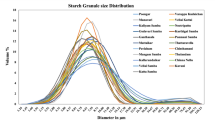Abstract
Of the 22 species within the Oryza genus, only two, O. sativa and O. glaberrima, have been domesticated. Although food security is supported by accessing wild Oryza resources for new genes and alleles which enhance plant performance, wild Oryza grain properties have not been extensively studied. Evaluation of the grain physico-chemical properties of eight wild Oryza species found amylose content, amylopectin structure and cooking properties fell within a narrow range relative to cultivated rice. The amylopectin of the wild species had a lower proportion of short branch chains (DP 6–14) relative to cultivated rice and were all of high apparent amylose content and gelatinization temperature. The grain of the wild species did not elongate to the same extent as the cultivated rice and had lower viscosity parameters. These results highlight how significant physio-chemical changes have been made by human selection in the domestication of rice, especially japonica rice. The wild species may be useful for improving the nutritional value of rice and other cereal crops.

Similar content being viewed by others
References
AACC (1995) AACC Method 61–02. Determination of the pasting properties of rice with the Rapid Visco Analyzer. In: Approved Methods for the American Association of Cereal Chemists, 9th edn. St. Paul, Minnesota, USA
Abd Allah MA, Mahmoud RM, El-Kalyoubi MH, Abou Arab AA (1987) Physical properties of starches isolated from yellow corn, sorghum, sordan and pearl millet. Starch 39:9–12
AOAC (1995) AOAC Official method 976.05—Automated Kjeldahl method. In: AOAC Official methods of analysis, 16th edn. Arlington, VA, USA
Bao JS, Zheng XW, Xia YW, He P, Shu QY, Lu X, Zhu LH (2000) QTL mapping for the paste viscosity characteristics in rice (Oryza sativa L.). Theor Appl Genet 100:280–284
Bao JS, Sun M, Corke H (2002) Analysis of the genetic behavior of some starch properties in indica rice (Oryza sativa L.): thermal properties, gel texture, swelling volume. Theor Appl Genet 104:408–413
Bhattacharya KR, Sowbhagya CM, Indudhara Swamy YM (1982) Quality profiles of rice: a tentative scheme for classification. J Food Sci 47:564–569
Bergman CJ, Bhattacharya KR, Ohtsubo K (2004) Rice chemistry and technology. In: Champagne ET (ed) Rice end-use quality analysis. American Association of Cereal Chemists, St. Paul, pp 415–472
Fitzgerald MA, Rahman S, Resurreccion AP, Concepcion J, Daygon VD, Dipti SS, Kabir KA, Klingner B, Morell MK, Bird AR (2011) Identification of a major genetic determinant of glycaemic index in rice. Rice 4:66–74
Hamaker BR, Griffin VK (1990) Changing the viscoelastic properties of cooked rice through protein disruption. Cereal Chem 67:261–264
Juliano BO (1979) Amylose analysis in rice - A review. In: Chemical Aspects of Rice Grain Quality. International Rice Research Institute, Los Baños, Philippines
Juliano BO, Onate LU, del Mundo AM (1965) Relation of starch composition, protein content and gelatinization temperature to cooking and eating qualities of milled rice. Food Technol 19:1006–1011
Juliano BO, Villareal CP (1993) Grain quality evaluation of world rices. International Rice Research Institute, Manila
Kennedy G, Burlingame B (2003) Analysis of food composition data on rice from a plant genetic resources perspective. Food Chem 80:589–596
Martin M, Fitzgerald MA (2002) Proteins in rice grains influence cooking properties. J Cereal Sci 36:285–294
Nakamura Y, Sato A, Juliano BO (2006) Short-Chain-Length distribution in de-branched rice starches differing in gelatinization temperature or cooked rice hardness. Starch 54:155–166
Nakamura Y, Sakurai A, Inaba Y, Kimura K, Iwasawa N, Nagamine T (2002) The fine structure of amylopectin in endosperm from Asian cultivated rice can be largely classified into two classes. Starch 54:117–131
O’Shea MG, Samuel MS, Konik CM, Morell MK (1998) Fluorophore-assisted carbohydrate electrophoresis (FACE) of oligosaccharides: efficiency of labeling and high-resolution separataion. Carbohyd Res 307:1–12
Patindol JA, Wang YJ (2002) Fine structures of starches from long grain rice cultivars with different functionality. Cereal Chem 79:465–469
Philpot K, Martin M, Butardo V, Willoughby D, Fitzgerald M (2006) Environmental factors that affect the ability of amylose to contribute to retrogradation in gels made from rice flour. J Ag Food Chem 54:5182–5190
Rice Technical Working Group, R.R.T.W (1997) National cooperative testing manual for rice: Guidelines and policies, page113. Philippine Rice Research Institute, Munoz
Reddy KR, Zakiuddin AS, Bhattacharya KR (1993) The fine structure of rice- starch amylopectin and its relation to the texture of cooked rice. Carbohydr Polym 22:267–275
Vaughan DA (1994) The wild relatives of rice. A genetic resources handbook. International Rice Research Institute, Manila
Acknowledgments
We thank Lyndon Brooks (Southern Cross University) for his assistance in statistical analysis, Oscar Larroque (CSIRO) Plant Industry, Canberra ACT 2601) and Margrit Martin for her technical assistance (NSW Department of Primary Industries, Yanco Agricultural Institute). This project was funded by the Grain Foods CRC, Australia.
Author information
Authors and Affiliations
Corresponding author
Additional information
Communicated by: Takuji Sasaki
Rights and permissions
About this article
Cite this article
Kasem, S., Waters, D.L.E., Ward, R.M. et al. Wild Oryza Grain Physico-Chemical Properties. Tropical Plant Biol. 7, 13–18 (2014). https://doi.org/10.1007/s12042-013-9133-1
Received:
Accepted:
Published:
Issue Date:
DOI: https://doi.org/10.1007/s12042-013-9133-1




